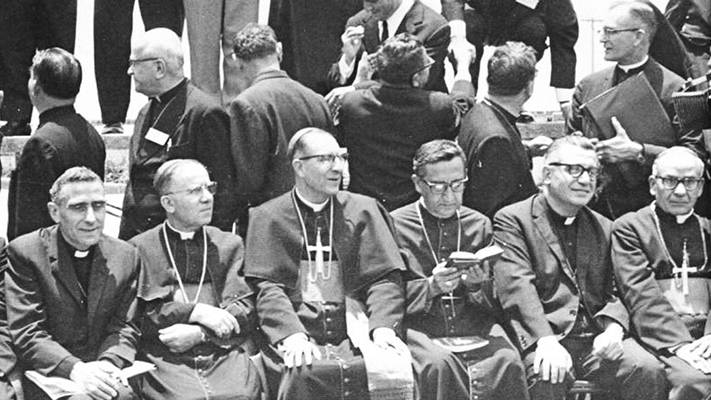

Medellín: 50 years later
Salt + Light Media
Wednesday, October 10, 2018

by Gustavo Morello, S.J.
Before Netflix’s Narcos, and even before Pablo Escobar, the name of the Colombian city of Medellín held a different place in the minds of many Latin Americans. It was, 50 years ago, the birthplace of liberation theology.
Between August 24 and September 6, 1968, 247 bishops from Latin America, together with Pope Paul VI, gathered in the city to reflect on the role of the Church in Latin America. In the final document of that conference, usually referred to as “Medellín,” the bishops acknowledged that life in many Latin American countries existed under the shadow of “institutional violence,” caused by inequality, imperialism, and dependence. It was a situation, they said, that was “unacceptable to anyone with any degree of awareness of human rights.”
The Medellín bishops’ conference marked a coming of age for Latin American Catholicism, with the concepts of “liberation theology,” “structural sin,” “preferential option for the poor,” and “Christian grass roots communities,” born during those debates. It was a watershed moment for Latin American Catholicism. They were trying to understand Jesus’ messages in Latin American societies, and liberation theology was the answer: a theology based on a reading of the Scriptures from a grassroots viewpoint. Liberation theology inaugurated a different perspective – that of the poor and disenfranchised – from which to read and understand 2,000 years of Catholic teaching. As we have seen, it was a perspective that was not always welcome in Rome.
A half century after Medellín, what has changed for Latin Americans? First and foremost, they and the rest of the world’s Catholics are led by Pope Francis, the Argentine Jesuit who became the first Latin American pope in 2013. Yet even in his home city of Buenos Aires – and across the region itself – there is greater openness to non-Western pastoral perspectives. For researchers, it has raised the question: how do Latin Americans "do religion" today? What has happened to their religiosity during the past 50 years?
With support from the John Templeton Foundation, our team of researchers interviewed more than 250 individuals in three Latin American cities, the most widespread qualitative study of lived religion in Latin America.
We spoke with individuals in Lima, Perú; Córdoba, Argentina; and Montevideo, Uruguay. In these three cities with shifting religious landscapes and diverse cultural histories, researchers found Catholics must now share space with Protestants and non-affiliated persons, often within their families. By the numbers, as a Pew Research Forum study found in 2014, Latin Americans make up a more diverse religious region than ever before: 69 percent of people in 19 South American countries identified as Catholic, while 19 percent identified as Protestant and eight percent identified as unaffiliated. This diversification is linked to the growing influence of evangelical Christians – a presence dating back to the 1950s – as well as the dynamics of globalization. Throughout Latin America, there is broad access to international goods, cultural trends, and also religious traditions.
Our respondents – Catholics, Protestants, and unaffiliated – confirmed this shift. They described to us how an era of globalization and the reach of technology have touched the religious lives of everyday Latin Americans in new and profound ways. More than two-thirds of the interviewees have frequent contact with persons that identify with a different religious tradition, an important change when compared to 50 years ago. Latin America is not just Catholic, but also Protestant and non-affiliated. Unfortunately, plurality has not meant dialogue. Most of the time respondents said they avoid talking about religion.
Today, people do many different things when they “do religion.” While many respondents do some sort of traditional praying – such as giving thanks, asking for something, meditating – just as many connect with God using technology, like streaming a liturgy, praying with their phones, or posting prayers on Facebook. Slightly less than a quarter of the subjects report some sort of “connection” when hiking in the mountains, running on the beach, or working out. For some, religion is literally under their skin – in the form of a tattoo with a transcendental meaning for them.
For these Latin Americans, the classical distinction between private religious places and secular public spaces has blurred. People do religion wherever they are and at any moment they feel they need it. Their religious practice is not confined to a brick-and-mortar church: they find sacred space wherever they can: from the dining room to the living room, during their commute, and even in the workplace.
Many participants experienced religion as a “work-in-progress.” Religion is an existential journey more than a dogmatic or intellectual destination. People are on religious paths and occupy certain “spiritual locations,” but they have not necessarily reached a “destination,” nor have they been looking for dogmatic clarity. To be a believer means to have doubts. The individuals we interviewed were comfortable talking about their doubts.
All of these perspectives tell us that religion is a greater presence in peoples’ lives than researchers expected. Religion in the region remains relatively undiminished. However, religion has changed and religious people are more autonomous from their institutions than religious leaders would wish. Latin Americans practice religion on their own terms, serving as their own religious authorities. Mandatory religious rituals are seen more as an imposition than a celebration. What is really important for most of the interviewees is the personalization of the experience. Religions provide symbols and narratives, but people use them to tell their own story. However, communities are relevant, and people join them. Many mentioned that their first religious experience happened in the context of a community, leaving a lasting impact, for good or bad.
While Latin Americans we spoke with see themselves as their own religious authorities, broader religious communities still matter. Reality remains steeped in transcendence. Still, they do not have spaces where they feel comfortable talking to others about religion. Further, adapting to this growing religious pluralization is difficult. It shows us that religiosity is more a work in progress than a fixed situation, a journey more than a destination.
Liberation theology was a way to understand Latin American societies and the role of the religious community in that context. What might be the role of religious communities today in Latin America? Our study suggests that Latin Americans experience their daily lives soaked in transcendence in many different ways, that the sacred is neither outside the secular aspects of life, nor limited by religious institutions. At the same time, they do not know how to engage with religious differences. Religions that can offer practices to experience transcendence in daily life, that can show how to share them with others, and that are aware that their role is more of a travel companion than an authority might be able to articulate an answer as relevant as liberation theology was in its time.
Today, Medellín is neither the same as it was in 1968, nor as it was portrayed in Narcos. To many Latin Americans, the name recalls the resiliency of the region's residents – referred to collectively as the “paisas” – and the transformation of the city. One can say the same about Latin American religiosity: it too has changed, but it is alive and vibrant.
Gustavo Morello, S.J., is associate professor of sociology at Boston College and the lead researcher in the study Lived Religion in Urban Context: A Study of Contemporary Experience of the Transcendent. To learn more about this project, visit the Lived Religion website.Want to hear more from Fr. Gustavo Morello?
Watch this episode of Subject Matters in which he speaks to Sebastian Gomes about his book: The Catholic Church and Argentina's Dirty War.
Related Articles:
<<













